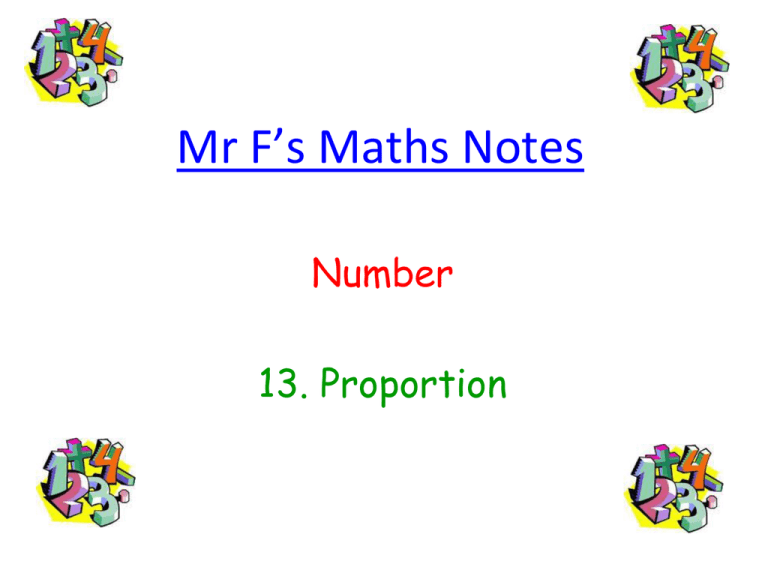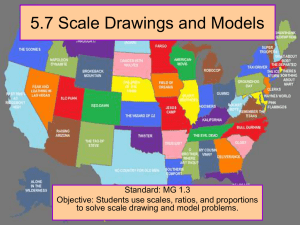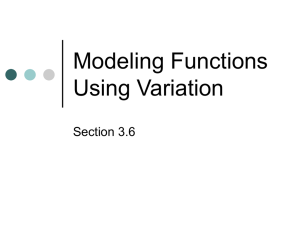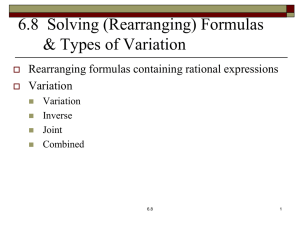Proportion - Paignton Online
advertisement

Mr F’s Maths Notes Number 13. Proportion 13. Proportion What does proportion mean, and what’s that funny fish symbol? If two variables are proportional to each other, it just means that they are related to each other in a specific way. The funny fish symbol just means “is proportional to” 1. Two types of Proportion Again, how many of these you need to worry about depends on your maths set, and your exam board, and stuff like that, but here are the two main types of proportion: (a) Direct Proportion Both variables increase or decrease together (i) Linear Graph Fancy Lingo yx y y is proportional to x y is directly proportional to x x y varies directly as x varies Example x could be the number of KitKat Chunkys that you buy y could be the total cost of those KitKat Chunkys As the number you buy increases, so too does the total cost (ii) Quadratic Graph Fancy Lingo yx y Example 2 x could be the amount of money you spend advertising a gig y is proportional to x2 y is directly proportional to x2 y varies directly as x2 varies x y could be the number of people who turn up to the gig As the amount of advertising increases, word of mouth quickly spreads, and the number of people who go to the gig goes up by a lot. (iii) Cubic Graph Fancy Lingo yx y Example 3 y is proportional to x3 y could be your maths exam mark y is directly proportional to x3 As the amount of time you spend revising on the site increases, everything begins to fall into place, and your marks just get higher and higher with each extra minute! y varies directly as x3 varies x x could be the amount of time you spend on mymaths.co.uk (b) Inverse Proportion As one variable goes up, the other goes down (i) Inverse Graph Fancy Lingo Note: Not a straight line! y y 1 x y is inversely proportional to x x Example x could be the number of people you convince to join you on a road trip y could be the amount each person must pay for petrol As the number of people in the car increases, the amount everyone has to pay falls (ii) Quadratic Inverse Graph Fancy Lingo y y 1 x could be the number of hours you spend watching Eastenders x2 y is inversely proportional to x2 x Example y could be your number of brain cells As the hours increase, your brain cells disappear and an increasing rate! 2. How to tackle proportion questions Whatever the question, whatever the type of proportion, this method will never let you down… hopefully! Method 1. Decide on the type of Proportion - Direct or Indirect? - Linear, Quadratic or Cubic? 2. Write the expression with the funny fish sign 3. Make the expression into an equation by using = and k 4. Use the numbers they give you to find out the value of k 5. Write down the formula 6. Answer the questions! And now I’ll take you through some pretty nasty examples, but each time we will use the same method, and everything will be fine… I promise! Example 1 y is directly proportional to x. Given that y = 12 when x = 4, calculate the value of: (a) y when x = 6 (b) x when y = 66 1. Okay, we’re in luck! The question has told us that we are dealing with direct proportion, and unless it says otherwise, we can also assume that it is linear. 2. The expression to say that y is directly proportional to x is: yx 3. Okay, this is the key bit. As I said at the start, proportional means related to in a specific way. Indeed, once you decide what kind of proportion you are dealing with, all you need to do to get from x to y is to multiply by a number, which we call k. Rule: Replace the sign with = and multiply the right hand side by k yx y kx 4. Now we use the numbers in the question and put them in our formula… when y = 12, x = 4 12 4k And a little bit of rearranging gives us the value of k 5. So now we have our formula: y 3x k 12 3 4 6. And now life is easy because we just need to substitute in numbers and maybe (for b) rearrange!! (a) Find y when x = 6 y 3x So… y 18 y 3 6 (b) Find x when y = 66 y 3x So… x y x 22 3 x 66 3 Example 2 The variables p and q are related so that p is directly proportional to the square of q. Complete the table of values p 0.5 q 2 12 27 1. Again, we’re in luck! The question has told us that we are dealing with direct proportion, and it also mentions the word “square” which means we are dealing with quadratic. 2. The expression to say that p is directly proportional to the square of q is: 3. Rule: Replace the sign with = and multiply the2right hand side by k p q2 p kq p q2 4. Now we look at the table and see what it tells us…. Well, it looks like when p = 2, q = 12, so let’s put that information into our formula! 2 2 144k 2 12 k And a little bit of rearranging gives us the value of k 5. So now we have our formula: 1 2 p q 72 k2 144 1 72 Note: I prefer a fraction to the horrible decimal 6. And now life is easy because we just need to substitute in numbers and maybe (for b) rearrange!! (a) Find p when q = 27 p 1 2 1 q p 27 2 72 72 1 p 729 So… p 10.125 72 (b) Find q when p = 0.5 p 1 2 q 72 q2 72 p q2 36 So… q 2 72 0.5 q6 Example 3 z is inversely proportional to t. Given that when t = 0.3 the value of z = 16, find the value of z when t = 0.5 1. Happy days! The question has told us that we are dealing with inverse proportion, and unless it says otherwise, we can also assume that there are no nasty squares or cubes around. 2. The expression to say that z is inversely proportional to t is: 3. Rule: Replace the z 1 t sign with = and multiply the right hand side by k, but be careful here! 1 z t z k t Note: We are multiplying by k, so it goes on the top! 4. Now we use the numbers in the question and put them in our formula… when z = 16, t = 0.3 16 k 0.3 k 0.3 16 4.8 And a little bit of rearranging gives us the value of k 5. So now we have our formula: 4.8 z t 6. And now life is easy because we just need to substitute in numbers: (a) Find z when t = 0.5 z 4.8 t z 4.8 0.5 So… z 9.6 Example 4 – Nightmare!!!! (a) Describe the variation using (b) Find the equation connecting the two variables y 5 125 x 5 25 1. Okay, we have a problem! The question doesn’t tell us what type of proportion we are dealing with… but wait a minute, as x goes up (from 5 to 25), so does y (from 5 to 125), so it must be Direct. Now, look at this… x 25 or x 52 But what type of direct proportion?... Well, to get from the first x value (5) to the second (25), y 5 125 you must multiply by 5. But for the y values, you must multiply by 25. Now, 25 is 52, so we must be talking x 5 25 quadratic proportion x5 (a) The expression to say that y is directly proportional to the square of x is: 3. For the equation, we do what we always do… Rule: Replace the 2 right hand side by k 2 y kx yx y x2 sign with = and multiply the 4. Now we have two sets of values to choose from to find k! I am going to choose the second, but it doesn’t matter, the answer will be the same… when y = 125, x = 25 y kx 2 125 k 25 (b) So… the equation is: 2 125 k 625 y 0.2x2 k 125 625 Which works with both sets of values in the table! k 0.2 Good luck with your revision!











